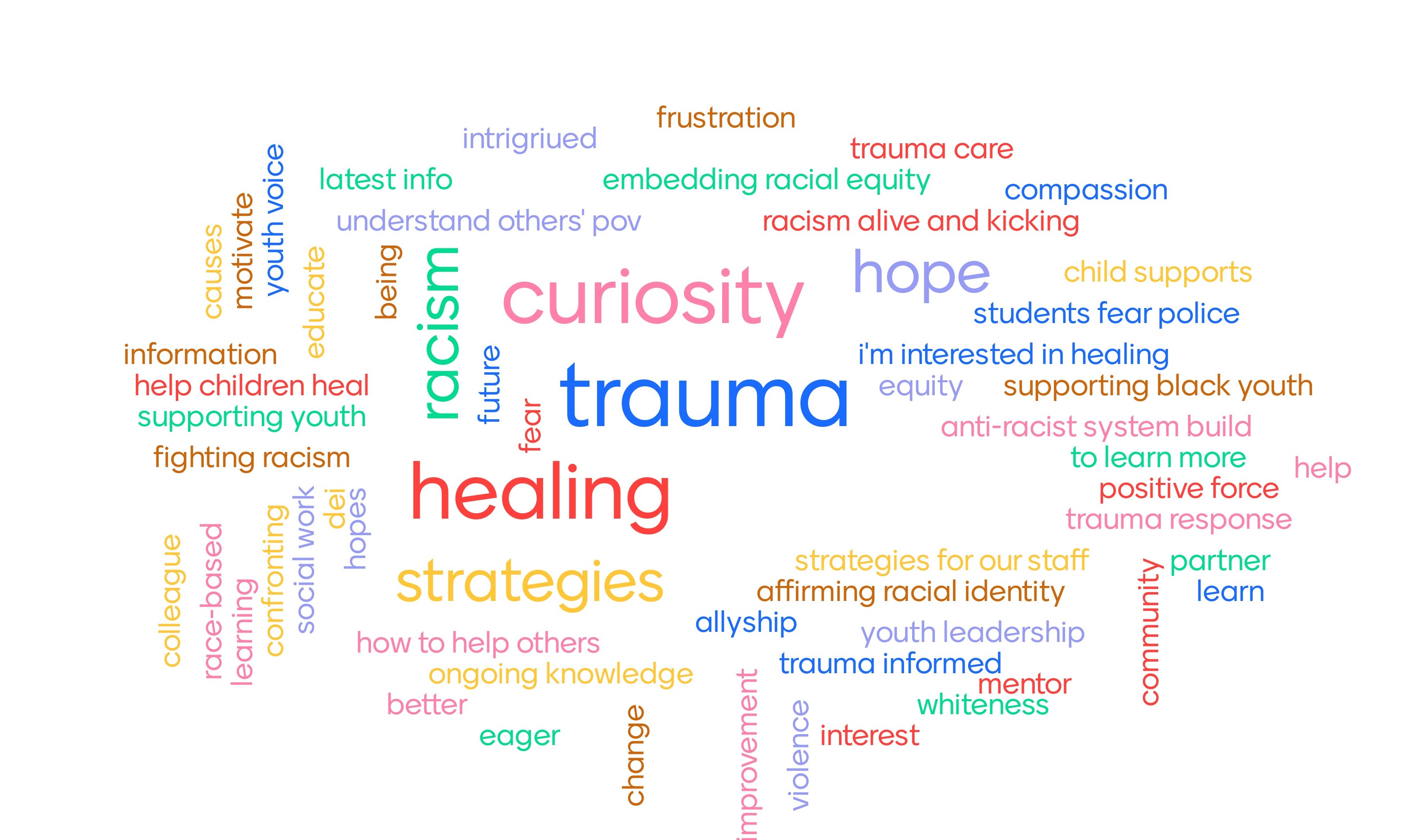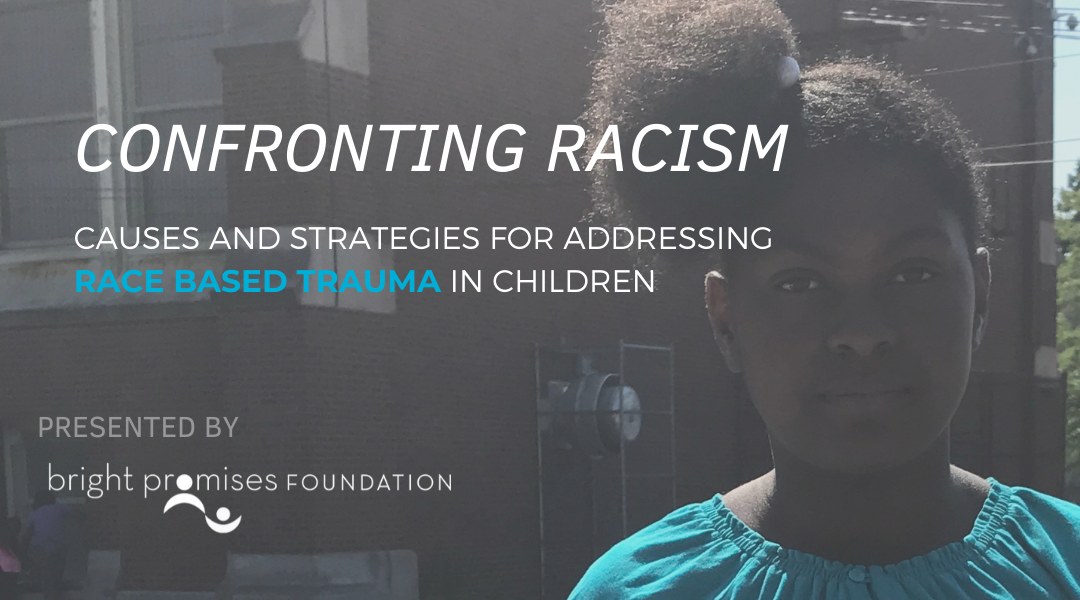Confronting Racism: Causes and Strategies for Addressing Race Based Trauma in Children
Confronting Racism: Causes and Strategies for Addressing Race Based Trauma in Children
A Virtual Conversation hosted by Bright Promises Foundation
On Thursday, May 6, Bright Promises Foundation presented a panel discussion with leading experts in the field of race-based trauma about how this issue impacts children and youth in our communities, and learn how you can help. It is increasingly well known that childhood trauma, if left unaddressed, can cause lifelong damage to the physical and mental health of young people. What is lesser known is how racism can cause significant and chronic traumatic stress in BIPOC (Black, Indigenous, and People of Color) children and youth. Trauma caused by racism affects youth in much the same way that general trauma does –research has linked racism to psychological distress, physical health problems, depression, anxiety, and children’s ability to succeed academically and socially.
The good news - caring adults can help to build protective factors that mitigate and even reverse the impact of trauma caused by racism on children and youth.
Watch the recording of this event to discover how you can help youth to exercise their own agency and to feel empowered, and how these actions can help both support healing from racially based traumatic stress and to give rise to the change we need as a society.
Featuring Expert Panelists:
- Clinton Boyd, Jr.,Ph.D. Postdoctoral Associate, The Samuel DuBois Cook Center on Social Equity at Duke University
- Aimee Hilado, Ph.D., LCSW Clinical Director, RefugeeOne Wellness Program & Associate Professor, Northeastern Illinois University
- Amber Mason, Ph.D. Director of Evaluation, Planning, Implementation, and Evaluation (PIE) Org
- Alec Ross, LCSW, Senior Director of Clinical Services, The Samuel DuBois Cook Center on Social Equity at Duke University
- Moderated by: Ed Davies, Director of Power of Fathers, Children's Home + Aid and Chair of the Bright Promises Foundation Program & Advocacy Committee
Q&A with the Experts:
- Does children's ability to ask questions about race/racism affect trauma?
Children can feel more comforted by explicit conversations about race/racism. Children have an understanding of race/racism from a very young age even if they do not use the terms so when adults give language to it (even the scary sides of racism), children feel supported because there is dialogue, transparency and are not left having to figure out the answers on their own. Open dialogue race/racism that is developmentally-appropriate can help young children organize their thoughts, emotions and reactions so adults shouldn't shy away from the conversations. Instead, lean in.
- Is the focus of this work to address negative behaviors or remove the cause of the trauma?
It has to be both. Addressing negative behaviors related to race-based trauma, though necessary for kids to function in their daily lives, is simply addressing the symptoms and not the cause. It must be a simultaneous, parallel process.
- How do we confront parents whose children make racial remarks to other children and how do we repair damage done by those remarks?
We need to lean into conversation that identify the impact of racial remarks that perpetuate negative stereotypes and bias. It can be as simple as approaching a parent and saying, "I overhead (child's name) say this statement to my daughter and it had an impact on her and me. I'll talk to my daughter about what his/her statement could mean. Would you be open to having the same conversation with your child? I want them be comfortable together and this is an important step."
When those types of racially literate conversations cannot happen, the work still must continue. We as adults need to have transparent conversations in all contexts when we are with children -- around our dinner table, in the classroom, in our agencies, in our communities -- that consistently call out harmful remarks that have an impact. Children need to see adults who can model the importance of recognizing racial bias/discrimination/microaggressions etc. in language/behaviors and describing it so they can do the same.
- What are specific examples of new evaluation methods for youth-informed mental health outcomes as well as evaluating trauma?
Focusing on process (versus products) and value-based care is gaining steam especially given our greater understanding of social determinants of health and the larger public health implications of social problems like racism, poverty, etc. Value-based care asks us to think about the benefits beyond enrollment and participation/attendance rates but instead focus on longer-term, quality of life gains at the individual and community level. It is about looking at systems that impact quality of life. This micro-macro view coupled with more process-focused evaluation methods are valuable and necessary for understanding youth-informed mental health outcomes.
- Do you think children are not included in these conversations and exercises because they are being held at "expert" levels of access? How do you think racial trauma makes it worse?
We have to think about the age of the child and what is an appropriate level of inclusion. The older the child, I believe the greater involvement is valuable and necessary but that doesn't mean younger, school-age children should not be included in some way. No matter the age, children/youth have ways of communicating their needs and we as adults need to be tuned into that. Often times racial trauma is the experience of being silenced. When programming is "dumped" on children, it may replicate feelings of being voiceless and forced which then defeats the purpose.
- What programs or treatment interventions have you observed to be most effective to address race based trauma in youth?
Peer programs where peers/leaders from the community are trained/mentored to deliver treatment rather than an outsider coming in. Collaborative treatments that center culture and client voice in the context of treatment are also useful when there is a combination of clinical work, psychoeducation, peer/family partnerships, and all is client-driven with a focus on process versus symptom reduction.
- How can we both help Chicago's youth today and amplify the scope and impact of our learning and co-creation?
Get them involved in planning, implementation and evaluation. Have their voice included to guide the process.
Key Takeaways Shared by Participants:

- “Denying the relevance, role, and impact of race when talking about childhood and youth trauma just makes no sense. If we accept the relationship, we can be smarter, more empathetic, and more effective. And youth already know the reality; we don't need to protect them from conversations about race, we need to work with them to repair the consequences of race.”
- “In order the change to happen for youth, it begins with adults.”
- “There are multidimensional impacts of race based trauma on youth and it is important to turn to youth as the experts in their experiences, to empower and uplift their voices to foster healing and change in micro and macro systems.”
- “I really enjoyed the perspective each individual brought and the ideas shared on ways we can start to do a better job of centering youth and their experiences navigating systemic racism and the trauma it causes.”
Additional Resources:
- Bright Promises Foundation White Paper on Race Based Trauma
- “The Link Between Racism and PTSD” by Dr. Monnica T Williams Ph.D.
- “American Psychology Special Issue: “Racial Trauma: Theory, Research, and Healing”, by Guest Editors: Lillian Comas-Díaz, Gordon Nagayama Hall, Helen A. Neville, Anne E. Kazak
- “#racialtraumaisreal” by the Boston College Institution for the Study and Promotion of Race and Culture





.png)
.jpg)
